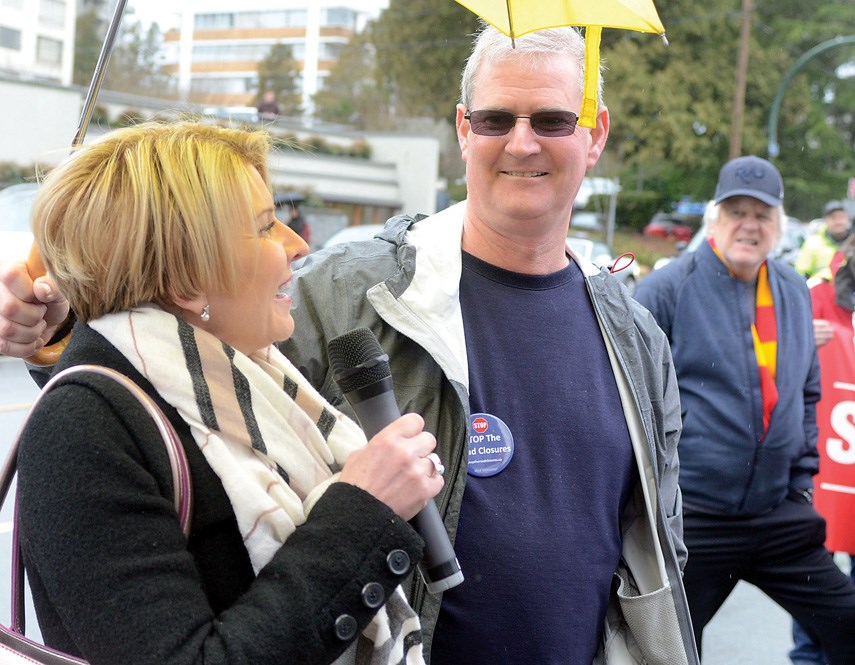The B-Line bus brouhaha will make at least one more stop at council chambers.
After a nearly five-hour meeting that included 59 speakers debating everything from the threat of climate change to Dundarave’s fragile charm, council deferred a vote that could halt the North Shore-spanning express bus at Park Royal.
The B-Line was originally slated to run from Phibbs Exchange in North Vancouver to Dundarave in West Vancouver.
But a motion put forward by Coun. Peter Lambur would nix part of that by eliminating bus priority lanes through the West Vancouver corridor and maintaining 25 parking spots in Ambleside. Council is now set to vote on the motion March 11.
“There have literally been a flood of letters and emails to mayor and council,” Lambur said, noting neither the Ambleside-Dundarave Business Improvement Area nor the Ambleside-Dundarave Ratepayers’ Association supported the B-Line.
Backing the B-Line up to Park Royal likely means TransLink will offer zero funding for road improvements west of the shopping centre, that had been included in the plan, Lambur said, suggesting the municipality may explore “going it alone” to pay for those.
Coun. Nora Gambioli called Lambur’s motion “totally premature”, noting it was put forward before the public consultation on the plan had concluded.
Under questioning from Gambioli, Lambur said he hadn’t seen the results of the district’s phone or online survey, which he dismissed as “flawed.”
The campaign to keep Ambleside safe from bus priority lanes has rekindled activism in West Vancouver, according to Anne Eady, who questioned TransLink’s motives.
“Was it really about mass transit? Where are the masses?” she asked. “Maybe it’s because TransLink would really like to get a toehold in here so we can have a string of developments.”
Addressing the B-Line proponents in the room, including Capilano University students, Eady encouraged them to get the facts and become: “the critical thinkers that your professors would like you to be.”
“We’re part of a bigger picture,” Rob Millard countered, discussing West Vancouver as part of the North Shore.
“You lose so much when employees have to beat the traffic to get out of here,” he said, adding teachers may be less inclined to volunteer after school due to commuting woes.
He was supported by West Vancouver Teachers’ Association president Renee Willock. “Many people from North Vancouver who teach your children and who work in your businesses commute east-to-west each morning,” she said. “We contribute to your traffic problems.”
Capilano University student Shaunti Bains implored council to consider residents who don’t take the bus due to its inefficiency. “Many people have to take their cars because it’s not feasible to take transit,” she said.
David Reinboth said it’s unlikely most people who own cars will suddenly switch to the bus.
Ian Dixon said the biggest issue is “what’s the cost to the drivers?”
Dedicated bus lanes would likely have a “neutral or positive” impact on traffic, according to a modelling study conducted by engineering and consulting firm WSP. The longest delay would be five seconds across five intersections, according to their report.
West Vancouver’s contribution to climate change is relatively miniscule, Dixon added, calling the pollution issue “a non-starter.”
Andrew Farris disagreed, calling the B-Line and bus priority lanes “tiny yet crucial steps” to reducing emissions.
“Those with entrenched economic power are going to fight us tooth and nail every step of the way,” he said. “If they cared about their children’s futures they would start from the premise that we have to immediately change the status quo.”
Former council candidate Andy Krawczyk urged prudence, suggesting voting on Lambur’s motion could “shortcut” community engagement.
“Poor engagement . . . is what got us into this mess in the first place,” he said.



